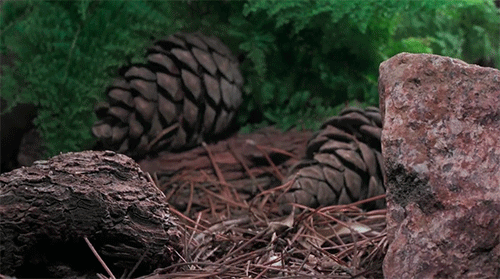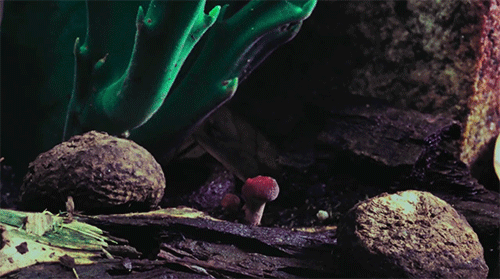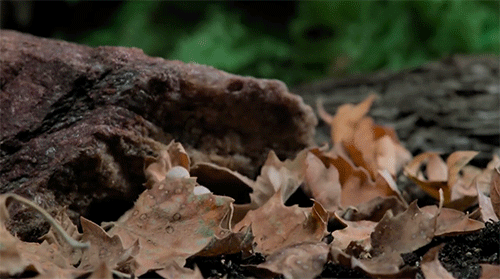Join me in exploring the world of fungi and understanding how different species of fungi can offer benefits toward society! A Personal Ecological Project for EEB 3001.
Don't wanna be here? Send us removal request.
Photo


Clavaria zollingeri (featuring slime trail that’s not part of the fungus)- Keweenaw Peninsula, Michigan
Facebook | Instagram | YouTube | Shop
652 notes
·
View notes
Text
Mutualism, decomposition, and the food web
The presence of fungi is crucial for the balance of almost every ecosystem on our planet. Without the aid of fungi food webs would be vastly incomplete. Why?
They’re decomposers - and they’re incredibly good at it! Saprobes (fungi that play the role of decomposers) secrete enzymes that allow them to feed on dead organic matter. These bodies of organic matter can consist of virtually anything - tree leaves, wood, biological waste, etc. You can learn a little bit more about saprobes, including some examples of them here.
So how do they play into ecology?
Fungi play crucial roles within ecological systems because without their properties of decomposition, the removal of waste and the recycling of nutrients would be much, much more difficult. Elements like phosphorus and nitrogen are key factors for plant growth (and can often times become environmental problems when mishandled in their own right), but are often not seen as plentiful within some biological systems (Source). Frankly put, none of our ecosystems would look the way they do now without fungi. Dead plants and animal carcasses would have nowhere to go and every consumer’s journey to find nutrients would be vastly different.
Mutualistic relationships allow for many species of plants and animals to prosper, and fungi play important roles here as well. I covered mychorrhizal fungi in one of my earliest blog posts, but there are many other examples. Lichens are composite organisms consisting of bacteria living among fungi species. You can often see them on rocks or trees if you were to walk outside.
We often take fungi for granted. They’ve been so important over the past billions of years that a claim like calling them “the backbones of our ecosystems” might not even be considered a hot take. Maybe today we could all take some time to give them a little thanks. :-)
0 notes
Text
Could we use fungi to treat our mental health?
Mushrooms are often eaten, grown, and studied - and, to varying levels of controversy, they are also used to induce psychedelic experiences. Regardless of personal experiences or opinions on the usage of psychedelics, I would like to use this post to discuss recent topics of research that could potentially bring new tools to the forefront of mental health treatment. While the use of drugs, including those with fungal origins, are prone to being under a hawk’s eye, recent studies focusing on psilocybin are providing potential advancements for mental health treatments on people with documented cases of major depressive disorder.
What is psilocybin?
Simply put: Psilocybin is a compound produced by over two hundred species of fungi. These fungi are grouped into a collective known as psilocybin mushrooms. The vast majority of these fungi are members of the Psilocybe genus. These psilocybin producing fungi are most known for providing psychedelic experiences with effects that are similar to those of LSD and other hallucinogens.
A look into the future
The use of psilocybin and other hallucinogens have long been banned in the United States since administrations in the 1960s, but within the last several years, clinical trials administering psilocybin treatments have been approved. The Food and Drug Administration has designated these trials as “breakthrough therapy,” which may mean that within the next few years we may see results from these trials (Source). Hopefully, the potential for psilocybin to treat major depressive disorder and other mental health issues can be further studied.

I am super curious to learn more about these treatments and if they can be used in the future for a good cause. While there certainly are controversies and adverse effects to using hallucinogens (Source), and while this is not a particularly common discussion about fungi to be had, I thought it would make an interesting blog post. If you enjoy TEDx Talks, I implore you to take fourteen minutes to listen in on Dr. Rosalind Watts and her experiences with clinical psychology from TEDxOxford here.
0 notes
Text
A podcast with a mycologist
If you enjoy podcasts, or if you’re completely new and trying to find a new way to spend your time in quarantine, I implore you to listen to this fun podcast episode about mycology! Alie Ward interviews mycologist and professor Tom Volk (University of La Crosse, WI) for her podcast “Ologies” on his career as a mycologist, the best way to forage for mushrooms, life cycles of fungi, how fungi impact human health, and many more incredible tidbits you might not hear about elsewhere!
You can listen to “Ologies with Alie Ward” episode “Mycology (MUSHROOMS) with Tom Volk) on her website here or on Spotify!
0 notes
Text
Fungi and healthcare
There is a long line of history in which research on fungi have lead to powerful discoveries and advancements in medical technologies. The most famous of these discoveries are fungal antibiotics. The most notable is penicillin, however there are a few others that deserve some recognition.
Penicillin
Alexander Fleming was widely attributed with discovering the antibacterial properties of Penicillium fungi. There are other claims to fame in the name of the discovery of penicillin, but all can be attributed to differences in the treatments and fungi used. Regardless of who owns the rightful claim to fame, the important take-away is that penicillin is a widely used medicine used to treat bacterial infections!
Cephalosporin
The Acremonium genus of fungi yielded a mould of what we now call cephalosporin. This antibiotic is commonly used to treat patients who are allergic to penicillin (such as myself). They are most effective against Staphylococcus and Streptococcus bacteria. It is also common to use this medicine directly after an organ transplant surgery in order to prevent a body rejecting a new organ.
Fungi’s medicinal properties are relative to both ecology and to society. Studying the different processes that fungi species undergo can provide useful breakthroughs that may advance our medical technologies. Only time will tell how many more wonderful treatments we might be able to discover by studying fungi!
(Source)
0 notes
Text
The world of culinary
Eating mushrooms on pizza will only provide you with the first taste of just how impactful fungi are to the world of cuisine! When was the last time you sunk your teeth into a warm slice of your favorite bread? Better yet, when was the last time you had heard or used the phrase “This is the best thing since sliced bread”? Regardless of your linguistic tendencies and your taste for baked goods, I can guarantee you that fungi are the best thing since sliced bread. In fact, without fungi, you probably wouldn’t be eating a lot of sliced bread!
Yeast are some of the coolest fungi and a large reason as to why is because they actively enable us to make some really delicious bakery items. The species of fungi we typically refer to as a baker’s yeast is one of the most well known members of the fungi kingdom, but we probably often take it for granted. Saccharomyces cerevisiae has served as an instrumental tool guided by the purpose of feeding us for centuries. These tiny eukaryotes are responsible for fermentation. But how does this process work, and most importantly, why should you care?
Fermentation is the process by which carbohydrates (sugars and starches) are converted under anaerobic conditions into alcohols and carbon dioxide gas. Those carbon dioxide gas molecules are responsible for creating air holes and giving rise to your bread when its cooking in the oven (Source). These reactions are crucial to providing the yeast fungi the energy that allows them to reproduce.
Centuries of food production rest on the hard working backs of yeast! Even if you don’t like bread, I bet you’ll thank yeast and their fermenting wonders when you enjoy your next cold can of beer!

0 notes
Text
Oh me, oh mycorrhizae!
In the fall of 2019 I had taken a course in environmental and soil microbiology. In the middle of the semester we took roughly a week to learn about mycorrhizal fungi, and little did I understand at first just how interesting and how vital they are to our lives. In particular, modern systems of agriculture would be nothing like they are without fungi to aid in gathering nutrients.
These fungi are housed within the rhizosphere, which is essentially the microbiome within soil where plant roots take hold. Mycorrhizal fungi spores within the rhizosphere grow into a connection of tube-like structures known as hyphae, break in and take hold inside plant roots. These hyphae are what allow the fungi and the plant to form a symbiotic relationship!
While the plant attains a source of sugar through its process of photosynthesis, the mycorrhizae take up different nutrients throughout the soil layer and exchange them for these sugars. Nutrients like phosphorus and nitrogen are vital for plant growth, which is why this association is so helpful. Estimates for mycorrhizal fungi associations like the ones I’ve described are though to exist within roughly 80% of land plants. All of these relationships are varied to different degrees, but having these associations have proven to be incredibly helpful.
I’ve linked here a video on YouTube that helps illustrate this relationship visually. Mycorrhizal fungi associations are generally very small and discernible to the human eye, so I thought that this video did an excellent job of visually providing an example of how these symbiotic relationships operate!
From Down To Earth Fertilizer, “What Are Mycos?”
2 notes
·
View notes
Text
An introduction to fungi
Welcome to my blog where I’ll be talking about fungi and how their interactions with society can benefit us! I’m starting this blog with very limited knowledge on fungi, and I’m hoping that as I research and write posts I can become more educated on their importance.
What exactly are fungi?
What look like the tiny little mushrooms on your pizza (if you’re that kind of person) are actually an incredibly resilient and important part of living on Earth.
Fungi have their own taxonomic Kingdom that is completely separated from all other forms of life on Earth. This includes plants, animals, protists, and bacterial forms of life. Fungi may look like plants, but they’re actually distinctly different both in biological makeup and function. Unlike plants, fungi do not photosynthesize but instead are heterotrophs. In order to attain energy they need to consume other molecules or living matter. Because of this process they are also Earth’s primary decomposers!
So... how are fungi actually useful?
I’m going to spend some time discussing this question using a series of blog posts where I’ll dive into a type of fungi and discuss its properties, habitat, and how it has positively (or negatively) affected society!
Thank you for joining me on this journey, I hope you’ll enjoy learning about fungi with me!
2 notes
·
View notes












